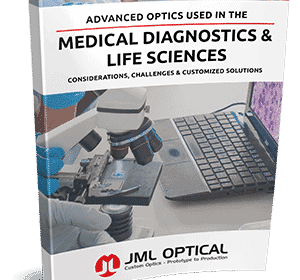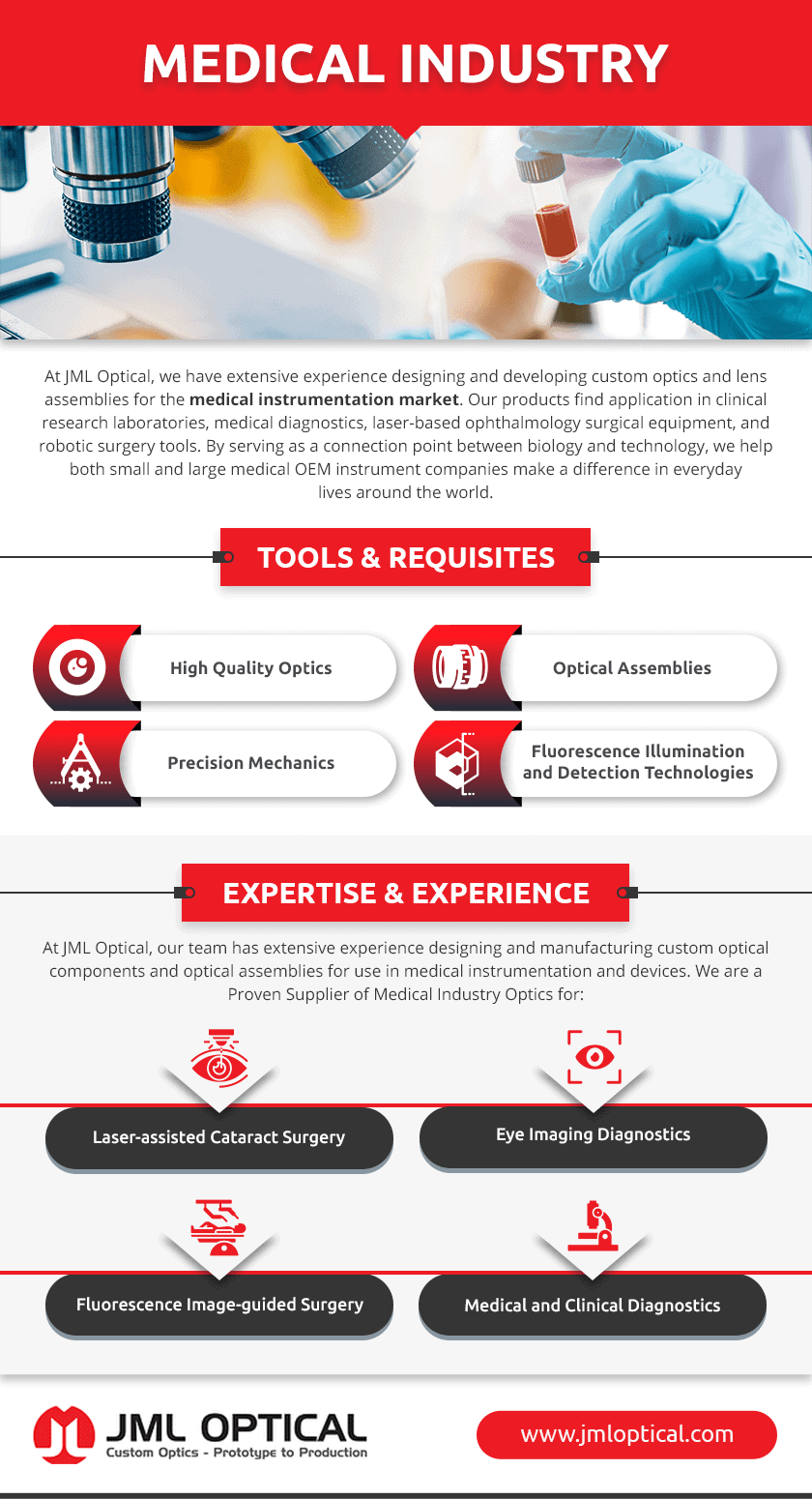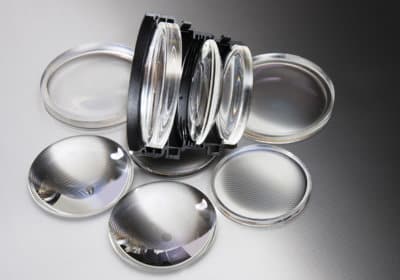Download Our eBook: Advanced Optics Used in the Medical Diagnostics & Life Sciences
Our eBook details the considerations, challenges and solutions kept in mind when manufacturing precision optics for medical applications across clinical and laboratory settings.
At JML Optical, we have extensive experience designing and developing custom optical components and lens assemblies for the medical instrumentation market. Our products find application in medical/clinical research laboratories, diagnostics (e.g., FDA approved DNA Sequencers, PCR instruments used in point of care applications), laser-based ophthalmology surgical equipment, and robotic surgery tools. By serving as a connection point between biology and technology, we help both small and large medical OEM instrument development companies make a difference in everyday lives around the world.
The Importance of Optical Lenses in Medical Technology
The use of optical technologies and techniques has paved the way for the development of more effective and efficient biological research tools. By drawing on the working principles of these tools, biotechnology companies can then transform them into instruments that facilitate patient diagnostic and treatment operations.
Design & Build Challenges in the Medical Technology Market
Optical components integrated into medical devices often have strict design and build requirements to ensure they function as intended. For this reason, biotechnology companies face numerous challenges when manufacturing products for use in this industry. Some of the factors they must consider include:
Standards and Regulations
In the medical device markets, some of the end-use equipment falls under strict regulations from the Food and Drug Administration (FDA) and other regulatory organizations. These requirements and restrictions focus on ensuring hygiene, efficacy, and safety. For a product to enter the market successfully, the design and construction must fully comply with several regulations and standards.
Cost
Changes in the healthcare environment, particularly regarding managed care facilities, have led to an increased focus on optimizing the total cost to employers. One solution the market has come up with is encouraging the use of minimally invasive therapies. For these procedures, precise and accurate equipment—including the optical components—is essential. Biotechnology companies must carefully design products with both manufacturability and cost in mind.
Performance
Some of the specifications required of optical components for medical devices include high magnification with low distortion for imaging applications, complex spectral coatings, tight optomechanical tolerances in assembly, and compactness and portability as well as the ability to work for several (5–7) years without the need for replacement. Given these requirements and restrictions, manufacturers continually face the challenge of balancing performance with size and working distance constraints.
Timeline
New medical devices often require a custom optical component or assembly, which takes time to design and develop properly. Many users are unaccustomed to the long production times required and may not even consider lens until they are further along in the product development cycle, which prompts manufacturers to hasten their timeline. At JML Optical, our QuickTurn Design and QuickTurn Optics solutions allow us to deliver complete optical assemblies in as little as four weeks without sacrificing product performance.
Applications of Optical Components in the Medical Technology Market
Optical components find application in many medical devices, including the following:
Laser-Assisted Cataract Surgery
In laser-assisted cataract surgeries, precision and accuracy are key. Before any incisions are made, the medical professional overseeing the operation uses optical coherence tomography (OCT)—a noninvasive imaging technique—to create a high-resolution, three-dimensional model of the eye. This model is then used to establish a detailed surgical plan that outlines the location, depth, and length of all incisions required. When used in conjunction with a femtosecond laser, it allows for ophthalmological operations to be completed with greater consistency and a lower risk of error.
Fluorescence Image-Guided Surgery
Fluorescence imaging is an optical imaging technique that facilitates the visualization of organic structures and processes in a living organism. It employs the use of fluorescent dyes that emit fluorescent signals when excited by a laser source and a fluorescence detection and tracking system. In surgical applications, it allows medical professionals to identify and target the necessary body structures while minimizing the number of incisions required. Fluorescence image-guided surgery (FIGS) technology is often used alongside robotic surgical equipment to achieve precise, accurate, and minimally invasive operations.
Medical/Clinical Diagnostics
Many of the newer medical and clinical diagnostic technologies and techniques rely on optical components for greater effectiveness and efficiency. For example, using in vivo optical imaging methods—e.g., confocal microscopy, microendoscopy, or optical coherence tomography (OCT)—allows medical professionals, clinicians, and researchers to detect and diagnose the spread of diseases such as cancer with greater speeds and at lower costs.
The integration of optics into diagnostic equipment enables OEMs to reduce overall product size without sacrificing imaging speed or resolution. These qualities are particularly critical for point-of-care diagnostic instruments. A smaller size translates to greater portability (making it easier to transport the necessary equipment to the patient for isolated cases or the hotspot in widespread cases) and lower production costs (resulting in a lower investment cost for customers).
JML’s Overall Design and Manufacturing Impact
At JML Optical, our team has extensive experience designing and manufacturing custom optical components and assemblies for use in medical instrumentation and devices, including fluorescence imaging, white light, phase contrast optical detection, and laser-based ophthalmic surgical tools and retinal imaging instruments. By partnering with medical device OEMs from the initial instrument concept stage all the way to volume production using our product development partnership model, we help develop reliable and durable optical product solutions for instrument OEM manufacturers around the world that help keep product development projects on time and on budget.
For more information on our optical capabilities, contact our experts or request a quote today.
GOING BEYOND THE QUOTE
Optical design team discovered that biometrics client requested a lens that was not the best match for its new product design.
TROUBLESHOOTING A CHALLENGING PERFORMANCE ISSUE
Manufacturing a high volumes, customer-designed, precision optical assembly for an FDA-regulated medical device.




